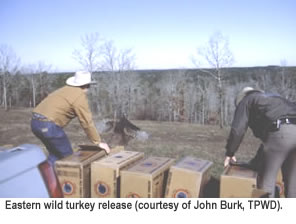Pineywoods Wildlife Management Upland Game
Bobwhite Quail populations in Texas have decreased at the rate of 4.7 percent annually over the last 18 years, according to the U. S. Fish and Wildlife Service's Breeding Bird Survey. The rate of decline in portions of East Texas is approaching 10 percent.
Biologists, researchers, and wildlife managers are unsure of what, exactly, is the specific cause of this decline. The list of possibilities includes widespread land use changes over the past 20 years (i.e., extensive plantings of monocultural forages, such as bermudagrass, and land fragmentation-rural land development), increasing number of predators due to the decline in the fur market, decreasing use of prescribed fire as a management tool, herbicides, pesticides, fire ants, over grazing, over hunting, aflatoxins and diseases. More than likely, it is a culmination of several of these factors acting simultaneously.
Decent quail populations can still be found in East Texas on some private lands that are practicing sound forestry and Bobwhite management; and on some National Forest lands, especially those areas that are being managed for Red cockaded woodpecker (RCW). RCW management is characterized by reducing the basal area of the stand, mid-story removal, brush hog mowing, and prescribed burning.
Dove hunting in the Pineywoods is fair, at best. Some of the best dove hunting can be found in recently harvested (within the last year or 2) timber stands or "clear-cuts". These areas typically have an ample supply of croton or "goatweed" due to the recent soil disturbance. In addition, clear-cuts that have been site-prepared with a herbicide treatment will have a tremendous amount of croton growing in it and usually a few doves utilizing them. Although good dove hunting spots are hard to find in the Pineywoods, the Post Oak and Blackland Prairie Regions do offer affordable ($40) public dove hunting on TPWD public dove leases.

Eastern wild turkey release.
Although Eastern wild turkey population densities vary greatly throughout East Texas, the restoration program has successfully achieved the goal of establishing populations throughout the region with an 80% success rate. Block stocking efforts were completed in 1999, with a total of over 7,200 turkeys stocked at 321 release sites in 57 counties. Population densities are highest in the Red River valley region, followed by northeast Texas and the southeastern Pineywoods. The first county-wide spring eastern turkey season was initiated in Red River County during April of 1995. Since 1995, hunting opportunity has expanded rapidly. Currently, there are 37 counties open for spring eastern turkey hunting in East Texas.
 (
(